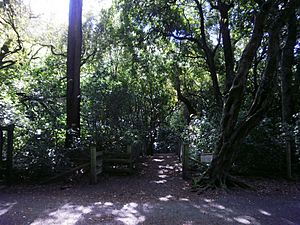Barton's Bush facts for kids
Barton's Bush is a special forest in Trentham Memorial Park, located in the Hutt Valley of New Zealand. It's the biggest remaining area of a unique type of forest called "lowland mixed podocarp/broadleaf forest." This means it has a mix of tall native trees like totara and matai, along with other leafy trees. The bush is named after Richard Barton, who bought land here in 1841. He wanted to make sure this beautiful part of the native forest was saved as the town of Upper Hutt grew and land was cleared for farms and homes.
Contents
The Story of Barton's Bush
Richard Barton's Vision
In 1841, a man named Richard Barton bought about 40 hectares (100 acres) of land in the upper Hutt Valley. He planned his new estate like a place called Trentham in England, where he used to work. This meant he cleared some land for farming and houses. But he also made sure to leave some of the natural bush untouched. Over time, Richard and his wife bought even more land. Their estate eventually stretched from Quinns Post to Silverstream, covering areas on both sides of the Hutt River.
Saving the Forest for Everyone
By 1924, Richard Barton's family started clearing more of the native bush. People tried to protect the remaining forest as a public park. They talked with the family and even asked the Minister of Lands for help. It wasn't until 1950 that enough money was raised to buy the bush area. They needed £26,000, which would be like £2,020,000 today! Half of the money came from a War Memorial fund. The rest was raised by public donations and contributions from the Upper Hutt Borough and Hutt County Councils.
Restoring the Bush
When Barton's Bush was bought, the idea was to save a piece of the forest. This would show what the land looked like before Europeans arrived in New Zealand. However, the bush wasn't perfect. In the 1940s, many trees had been cut down. Over 100 Totara trees were felled, based on the stumps left behind.
The forest also had a problem with harmful plants. These included Old Man's Beard (Clematis Vitalba) and Wandering Jew (Tradescantia Fluminensis). These plants can harm the native forest. Since 1980, people have worked hard to remove these pest plants. They have also planted more native trees and plants to help the forest grow back strong.
In recent years, the walking paths in the bush have been improved. They've been covered with gravel and lightly fenced. This helps people stay on the paths. It also protects the delicate plants and animals living in the forest's undergrowth.
Plants and Trees of Barton's Bush
More than 100 different kinds of native plants live in Barton's Bush. Most of the tall, mature trees that form the forest roof are Tawa trees. You can also find some large Totara, Matai, and Kahikatea trees.
Below these tall trees, there are many other native trees and smaller plants. Even though people have changed Barton's Bush a bit over time, it still gives us a good idea. It shows what the lowland forests looked like when the first European settlers came to the Hutt Valley.


